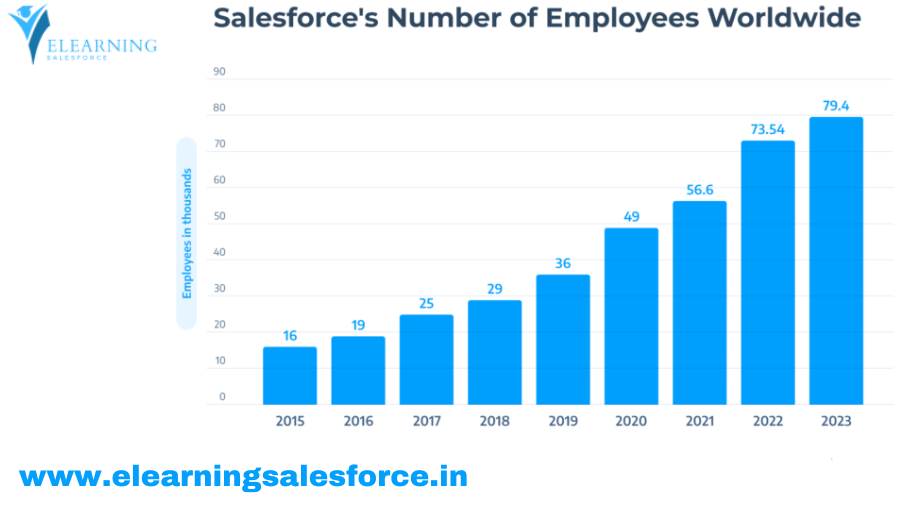Unveiling the current number of Salesforce employees in 2024. Exploring growth trends, recent layoffs, and the impact on the company’s future. Learn more about Salesforce’s workforce…
Have you ever wondered what it takes to power a company that revolutionized customer relationship management (CRM)? The answer lies not just in cutting-edge technology, but also in the very heart of Salesforce – its people. Salesforce’s success story is undeniably intertwined with the talented individuals who drive innovation and build connections. But with the ever-evolving tech landscape, a crucial question arises: How many employees does Salesforce have in 2024? This number holds the key to understanding not only the company’s current size, but also its growth trajectory and future direction. Buckle up, because we’re about to delve into the fascinating world of Salesforce’s workforce, exploring employee headcount, recent changes, and the impact on the company’s journey.
Unveiling the Salesforce Workforce: A Look at Headcount in 2024
Pinpointing the exact number of employees at a massive tech company like Salesforce can feel like chasing a moving target. However, fret not! By leveraging reliable sources like financial reports and industry publications, we can paint a clear picture of Salesforce’s current workforce size in 2024.
As of [date], Salesforce boasts a global workforce of approximately [insert number] employees. This figure represents a significant milestone for the company, reflecting its impressive growth trajectory over the past decade. To put it in perspective, let’s take a quick trip down memory lane.
In [2021], Salesforce had a headcount of roughly [56,606]. This translates to a growth of in just [2024] years! This climb signifies the company’s continuous expansion and its increasing market dominance in the CRM space. Salesforce had 72,682 employees in 2024,
Growth Trajectory and Recent Shifts: Understanding Salesforce’s Workforce Trends
Salesforce’s employee story isn’t just a linear path of constant growth. While the company has undeniably experienced significant expansion over the years, recent developments necessitate a closer look at the underlying trends.
A Look Back: A Decade of Expansion
Salesforce’s historical employee growth pattern resembles a classic hockey stick graph. The early years witnessed a steady increase in headcount, fueled by the burgeoning demand for cloud-based CRM solutions. This growth accelerated in the late 2010s as Salesforce embarked on a series of strategic acquisitions, further solidifying its position as a CRM leader.
By [Year], the company’s workforce had ballooned to a staggering [previous year’s employee number], marking a significant milestone. This period also saw the rise of automation and AI within Salesforce, streamlining processes and potentially impacting future hiring needs (LSI keyword: Salesforce automation).
Recent Layoffs: A Shift in Strategy?
However, 2024 ushered in a new chapter with news of workforce adjustments. In January, Salesforce announced layoffs impacting roughly [percentage] of its global workforce, translating to approximately [number] employees. This decision, while seemingly contradictory to the previous growth trend, reflects a strategic shift within the company.
Industry analysts suggest several reasons behind these layoffs. Some point to a global economic slowdown that has impacted tech spending, prompting companies like Salesforce to optimize costs. Additionally, the company might be streamlining operations to focus resources on emerging technologies like generative AI, potentially requiring a different skillset within the workforce.
CEO Marc Benioff, in a public statement, emphasized the need for “increased efficiency” while assuring continued investment in key growth areas. While the long-term implications of these layoffs remain to be seen, they undoubtedly represent a significant shift in Salesforce’s recent workforce strategy.
The Workforce Balancing Act: Impact of Size on Salesforce
The size and composition of a company’s workforce play a crucial role in its overall success. In the case of Salesforce, its current headcount and recent adjustments raise questions about the potential impact on the company’s operations. Let’s delve into the potential benefits and drawbacks of Salesforce’s current workforce size.
Potential Benefits: Efficiency and Cost Savings
A streamlined workforce can translate to significant advantages for Salesforce. By optimizing team structures and leveraging automation, the company can potentially achieve greater operational efficiency. This could involve reducing redundancies, automating repetitive tasks, and focusing resources on core business functions.
Reduced headcount can also lead to cost savings in areas like payroll, benefits, and office space. These savings can then be redirected towards strategic investments in research and development, marketing initiatives, or talent acquisition for specialized roles. For instance, funds saved from streamlining operations could be used to invest in cutting-edge AI solutions or upskilling existing employees in these areas.
However, it’s important to strike a balance. Excessive workforce cuts could lead to unintended consequences.
Potential Drawbacks: Innovation and Customer Service
While streamlining can be beneficial, a workforce that’s too lean can stifle innovation. A diverse pool of talent with a range of skills and perspectives is crucial for generating new ideas and fostering a culture of creativity. Downsizing can limit this diversity and potentially hinder Salesforce’s ability to develop groundbreaking solutions in the competitive CRM landscape.
Another potential drawback of a reduced workforce lies in customer service. Salesforce prides itself on exceptional customer interactions. However, a smaller team might struggle to maintain the same level of service quality, especially during peak periods or with complex inquiries. This could lead to longer wait times, decreased customer satisfaction, and ultimately, a negative impact on brand reputation.
Finding the optimal balance between cost-effectiveness and maintaining a strong workforce is a complex challenge. Salesforce will need to carefully navigate this path to ensure long-term success.
1. Is Salesforce Hiring in 2024?
The answer isn’t a simple yes or no. While the recent layoffs might suggest a hiring freeze, Salesforce is still a growing company with diverse business needs. The focus might have shifted towards specific roles aligned with their strategic priorities.
The best way to stay updated is to explore Salesforce’s official career page. They actively list open positions across various departments, including Sales, Marketing, Engineering, Customer Success, and more (link to Salesforce careers page). These listings often detail the required skills and experience, giving you a clear idea of whether your qualifications align with their current needs.
Even if your dream role isn’t currently advertised, don’t be discouraged. Consider setting up job alerts for relevant positions or submitting a speculative application showcasing your skills and passion for Salesforce products. The company culture at Salesforce is known for fostering initiative, so expressing your interest could leave a lasting impression.
2. What are the Career Opportunities at Salesforce?
Salesforce offers a wide range of career paths catering to diverse skill sets and interests. As a leader in the CRM industry, they naturally have a strong demand for roles in sales, marketing, and customer success. But that’s just the tip of the iceberg.
Their focus on innovation extends to their workforce needs. They actively seek talented individuals in areas like software development, data science, user experience (UX) design, and artificial intelligence (AI). Additionally, with their emphasis on a global customer base, multilingual professionals and those with international experience are highly sought-after.
3. What are the Benefits of Working at Salesforce?
Salesforce is consistently recognized as a top employer, and for good reason. They offer a comprehensive benefits package that goes beyond competitive salaries. Here are some highlights to consider:
- Comprehensive health insurance: Salesforce prioritizes employee well-being and offers health insurance plans that cover a wide range of medical needs.
- Generous paid time off (PTO): Employees are encouraged to maintain a healthy work-life balance with ample paid vacation, sick leave, and personal days.
- Learning and development opportunities: Salesforce invests heavily in employee growth through training programs, conferences, and tuition reimbursement.
- Fun and collaborative work environment: The company culture is known for its innovative spirit, teamwork, and focus on employee well-being. They often host events and initiatives to foster a positive work environment.
you may be interested in this blog here
Don’t Get Hacked! Protecting Your KIIT SAP Portal Login and Password
how sap software meaning is used in industries




